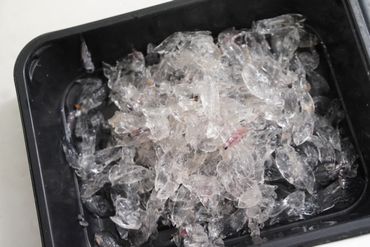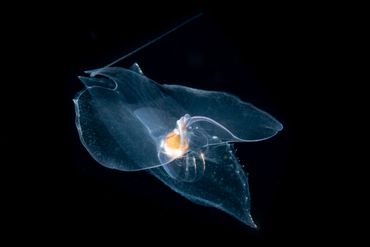
The glass slipper of Cymbulia: the sea butterfly wonder of the ocean
Naturalis Biodiversity CenterVote now for Cymbulia peronii in the ‘Mollusc of the Year 2022’ election.
On a quiet day, this sea butterfly glides with a downwards wingbeat like a spaceship moving through the ocean. Actually, it swims backwards, as the rearmost part of its shell is then pointing forward. However, when threatened, it changes gear and reverses. It then propels its shell through the water with the front forwards and shoots away with a speed of up to 45 centimeters per second. That is more than seven times its body length in a second! We are talking about Cymbulia peronii: a sea butterfly that belongs to the winged snails, or pteropods.
Mollusc of the Year
 Cymbulia peronii is almost entirely transparent, at most six centimeters in size, and has a flexible soft shell. Bram Couperus, marine biologist at Wageningen Marine Research, and his colleague Katja Peijnenburg from Naturalis have nominated the species for the ‘Mollusc of the Year 2022’ competition, organized each year by the Senckenberg Research Institute and the LOEWE center in Germany. C.peronii is among the top five nominees and therefore has a chance of winning. You can vote until March 15th. This is not just an honorary title: the winner will be awarded a complete sequencing of its genome.
Cymbulia peronii is almost entirely transparent, at most six centimeters in size, and has a flexible soft shell. Bram Couperus, marine biologist at Wageningen Marine Research, and his colleague Katja Peijnenburg from Naturalis have nominated the species for the ‘Mollusc of the Year 2022’ competition, organized each year by the Senckenberg Research Institute and the LOEWE center in Germany. C.peronii is among the top five nominees and therefore has a chance of winning. You can vote until March 15th. This is not just an honorary title: the winner will be awarded a complete sequencing of its genome.
Each year, Couperus, together with researchers from other countries, investigates the blue whiting: a fish species that occurs at a depth of about 450 meters. In the Atlantic Ocean to the west of Ireland, they took five plankton samples with a large and coarse plankton net in which they found large numbers of Cymbulia peronii. “Their numbers are probably considerably underestimated because most plankton researchers do not fish at this depth and sea butterflies avoid the smaller nets,” Peijnenburg says about this species.
Unusual shells
Cymbulia is one of many sea butterfly species. This group plays a significant role in the ocean ecosystem. The shells of the different species vary considerably. Some have a hard shell, half a shell, or even lack a shell entirely. Others have a soft shell, made from a gelatin-like transparent material, like the glass slipper of Cymbulia. Hard shells dissolve in acidifying waters, which makes them sensitive to ocean acidification. Sea butterflies with a hard shell are therefore seen as canaries in the coal mine: an indicator for ocean acidification.
 The group to which Cymbulia belongs, called the pseudothecosomata, is very interesting for further research. Closely related species within this group exhibit a huge diversity in shells. This suggests that sea butterflies have a broad adaptability with respect to ocean acidification. Some species are better adapted to acidification than others, which could cause large shifts in marine food chains. A good understanding of these changes is therefore important.
The group to which Cymbulia belongs, called the pseudothecosomata, is very interesting for further research. Closely related species within this group exhibit a huge diversity in shells. This suggests that sea butterflies have a broad adaptability with respect to ocean acidification. Some species are better adapted to acidification than others, which could cause large shifts in marine food chains. A good understanding of these changes is therefore important.
The flexibility and adaptability with respect to their shells are fascinating, but we do not yet know how it works. Their genome, all DNA codes with genetic information about their characteristics, is probably highly flexible, which allows them to adapt to their environment. However, not a single genome of a sea butterfly is known yet. At present, we only know the code of small pieces of the genome, some of the genes. Peijnenburg explains what we could find out if we knew the entire genome: “We conduct a lot of evolutionary and genetic research, and without knowing the genome, we’re swimming in the dark. We are investigating how sea butterflies produce their shells and which proteins these contain. We then try to link that to the different genes. We are now making good progress, but with a complete genome, we could map everything better and see which genes work together.”
The Cymbulia peronii glides like a spaceship through the Mediterranean Sea (Source: Eric Amiel)
Wonders of the ocean
Besides their fairylike appearance, sea butterflies form an important link in the food chain and are very important in the global carbon cycle. In their shells, they store carbon from the atmosphere. Furthermore, sea butterflies produce a mucous web to capture their food. In some species, such as Cymbulia, this web can be up to two meters in size. Once the sea butterflies have consumed their prey, all of the mucus sinks to the ocean floor. The mucus is part of the so-called marine snow: a vital source of food for deep-sea animals and important because it takes so much carbon out of the atmosphere.
Fortunately, we do not have to be too worried about the disappearance of sea butterflies as a group due to ocean acidification. Peijnenburg explains that she is not that pessimistic about their fate: “These animals will definitely survive beyond us. They have been around for millions of years, even earlier than the dinosaurs, and humans have only just appeared on the scene. I think that humans, just like dinosaurs, will become extinct before these sea butterflies.” Nevertheless, ocean acidification is a problem because it is rapidly continuing due to continued CO2 emissions and some species are very vulnerable. This may cause entire ecosystems to collapse.
Even though this sea butterfly was first described at the start of the 19th century, we still know little about Cymbulia and other sea butterflies. Therefore, there is enough to investigate, and an entire sequencing of the genome would definitely help with that. Vote now for the Cymbulia peronii in the ‘Mollusc of the Year 2022’ election and bring us a step closer to unravelling its secrets.
Text: Joyce Andringa, Naturalis Biodiversity Center
Photos: Linda Ianniello; Bram Couperus
Film: Eric Amiel, BioObs
